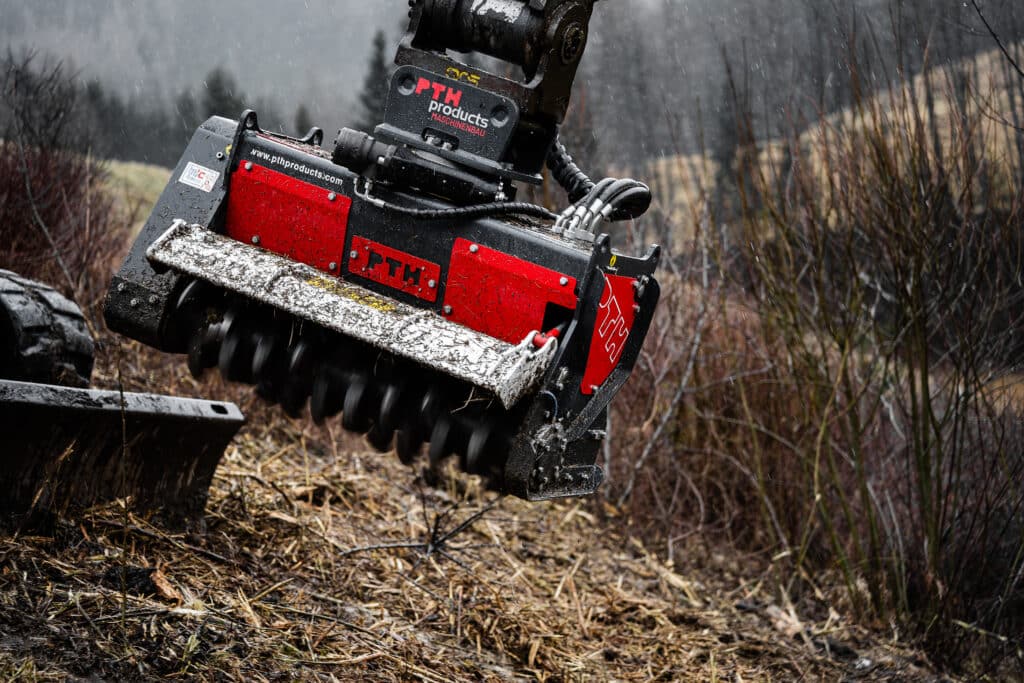Slope maintenance with system.

Slope maintenance refers to the regular care and maintenance of sloping surfaces, such as roadsides, railroad lines, embankments, ditches or river banks.
Slope maintenance fulfills important functions such as erosion protection, infrastructure stability and ecological compensation areas.
Slope maintenance is an important part of infrastructure, nature and landscape conservation. It requires specialist knowledge of vegetation, soil protection and technical processes - and of course the right choice of equipment.
mulching or milling ?
This is usually suspected, MULCHES is cheaper, but a closer look shows that mulching is often necessary 2-3 times a year. Mulching only cuts off what is visible and enables rapid regrowth.
MILLING literally gets to the root of the problem. The roots are milled to a depth of around 5 cm and rapid regrowth is thus permanently inhibited.


The PTH Excavator Crusher is the ideal machine for efficient, ecological and sustainable slope maintenance.
The PTH ExcatavorCrusher is MORE than just a forestry tiller, it has also been designed for processing hard rock (stone crusher) and wood.
The attachment is possible in 2 models on excavators from 5 - 14 t or 10 - 25 t.
The PTH ExcavatorCrusher is characterized by the PTH rotor with Bitlimiter technology, particularly solid and durable components and, depending on the model, 1 or 2 hydraulic flaps.
... what do the care professionals say?
- Depth effect and root canal treatment:
- Milling: An embankment tiller not only works on the surface, but also penetrates deeper into the ground. The roots of the vegetation (grass, herbs, smaller shrubs) are also captured, shredded and broken up. This dries out the roots and prevents them from sprouting again so quickly.
- Mulching: A mulcher only cuts off the vegetation above ground and shreds it. The roots remain intact and sprout again after a short time. The result is only a very short-term reduction in vegetation.
- Sustainability and maintenance intervals:
- Milling: The destruction of the root system significantly delays the regrowth of vegetation. As a result, the maintenance intervals are considerably longer with tilling. Instead of annual or even repeated maintenance per year, as is often the case with mulching, tilling can achieve a maintenance interval of 2-3 years make it possible. This saves considerable costs in the long term (machines, personnel, time).
- Mulching: As the roots remain intact, a mulched embankment needs to be maintained much more frequently.
- Slope stability and erosion protection:
- Milling: Although the root system is broken up, the root body remains in the slope. This decomposes slowly and continues to help stabilize the soil. The milled area is then "clean", without stumps or large plant remains, which can promote uniform new greening.
- Mulching: Mulching alone offers only limited erosion protection, as it only treats the vegetation superficially. The surface may be protected by the mulch layer in the short term, but the deeper stability provided by a healthy root system is not promoted or restored in the long term.
- Surface preparation for reseeding/replanting:
- Milling: A milled embankment provides an ideally prepared area for new planting or reseeding. The soil is loosened and cleared of old, unwanted vegetation, which favors the growth of new, desired plants (e.g. special grass mixtures for embankments).
- Mulching: In a mulched area, the old root system remains and the dense layer of mulch can make it difficult for new seeds to germinate.
- Removal of problematic vegetation:
- Milling: Effective for removing problematic vegetation such as thorny undergrowth, small trees or invasive species whose roots would otherwise sprout again and again.
- Mulching: Mulching is often not sufficient in the case of heavy scrub pressure, as it only shreds the above-ground plant material.
- Visibility (on traffic routes):
- Milling: Ensures a clear view along roads and paths for longer, as sprouting is greatly reduced.
- Mulching: The rapidly growing vegetation can quickly restrict visibility again.